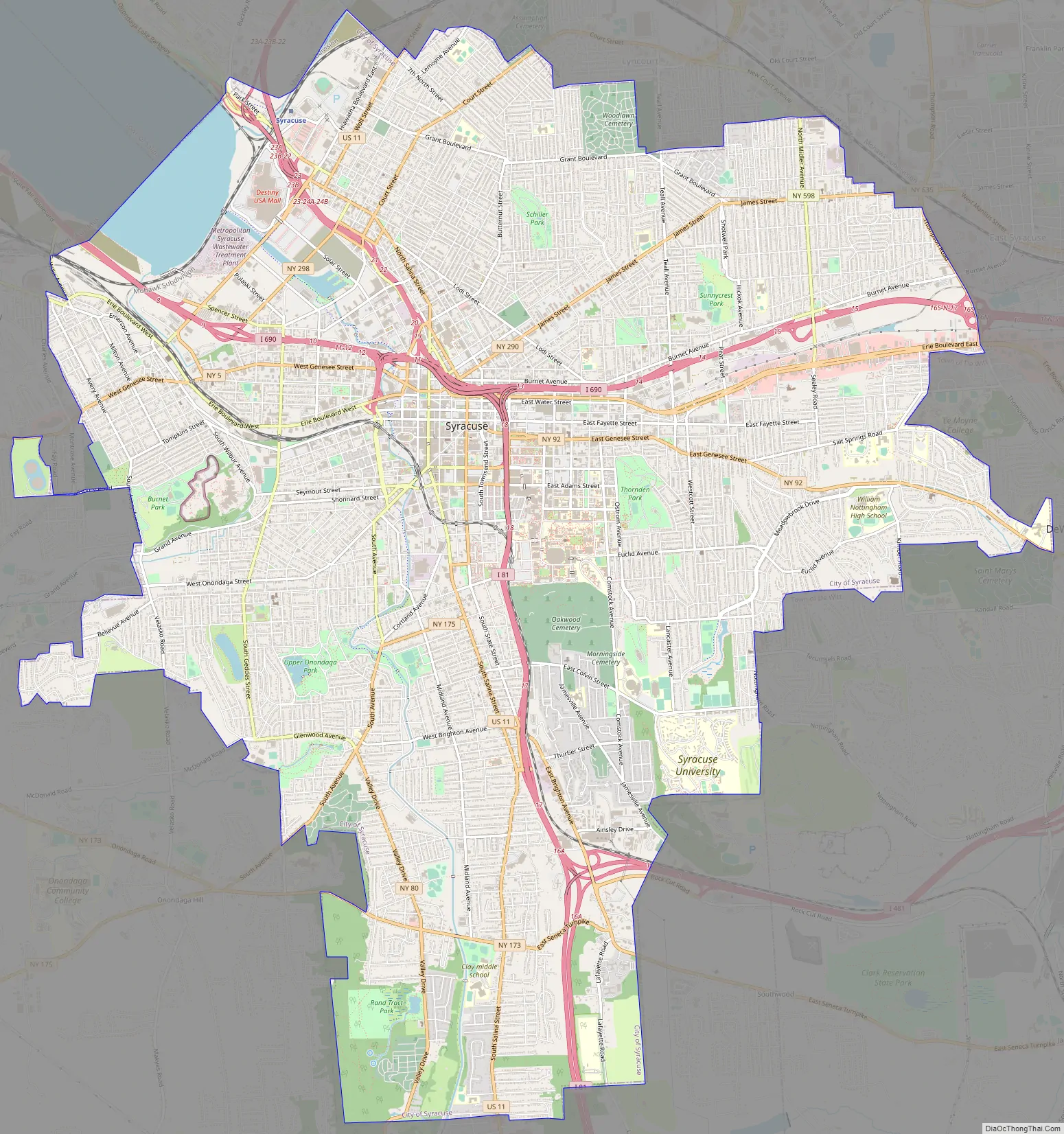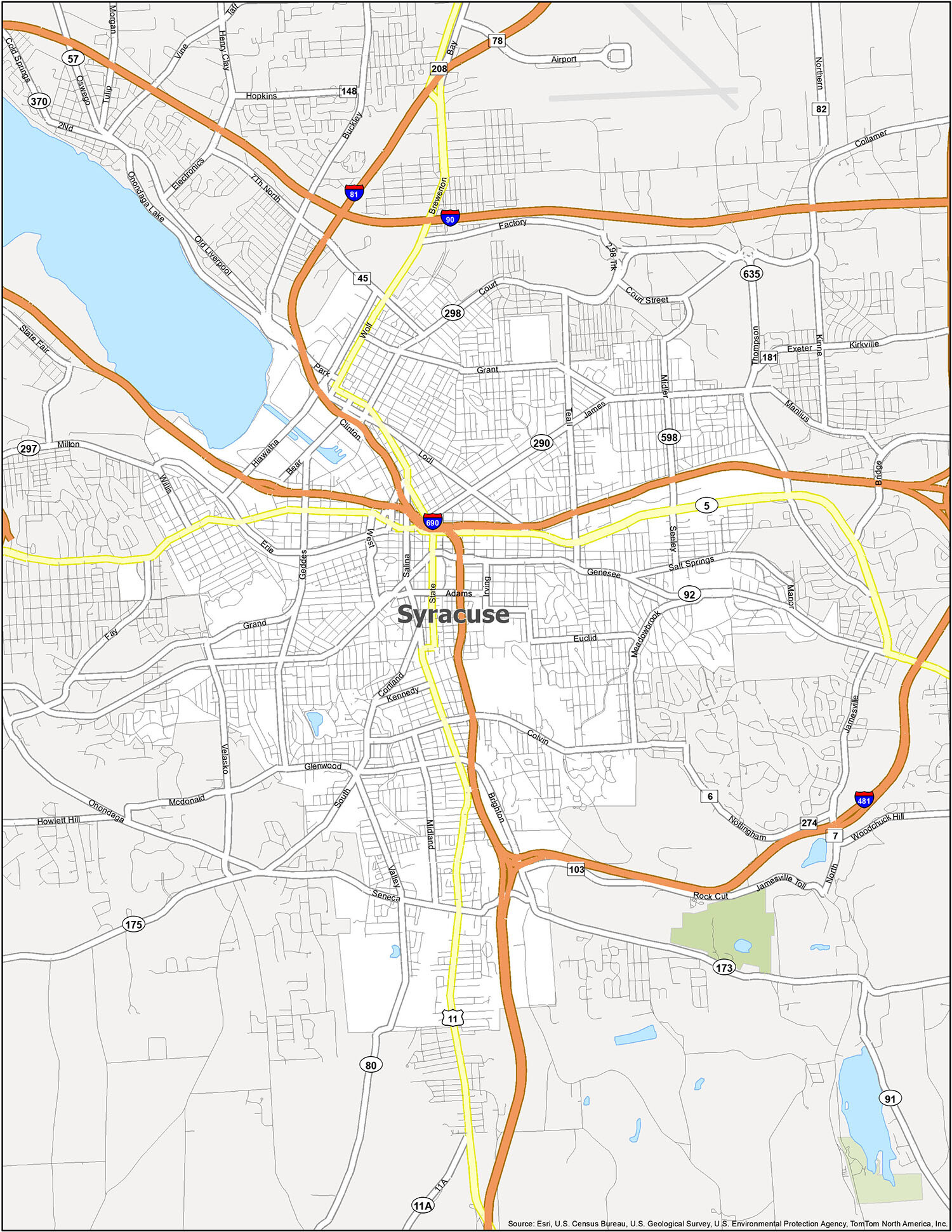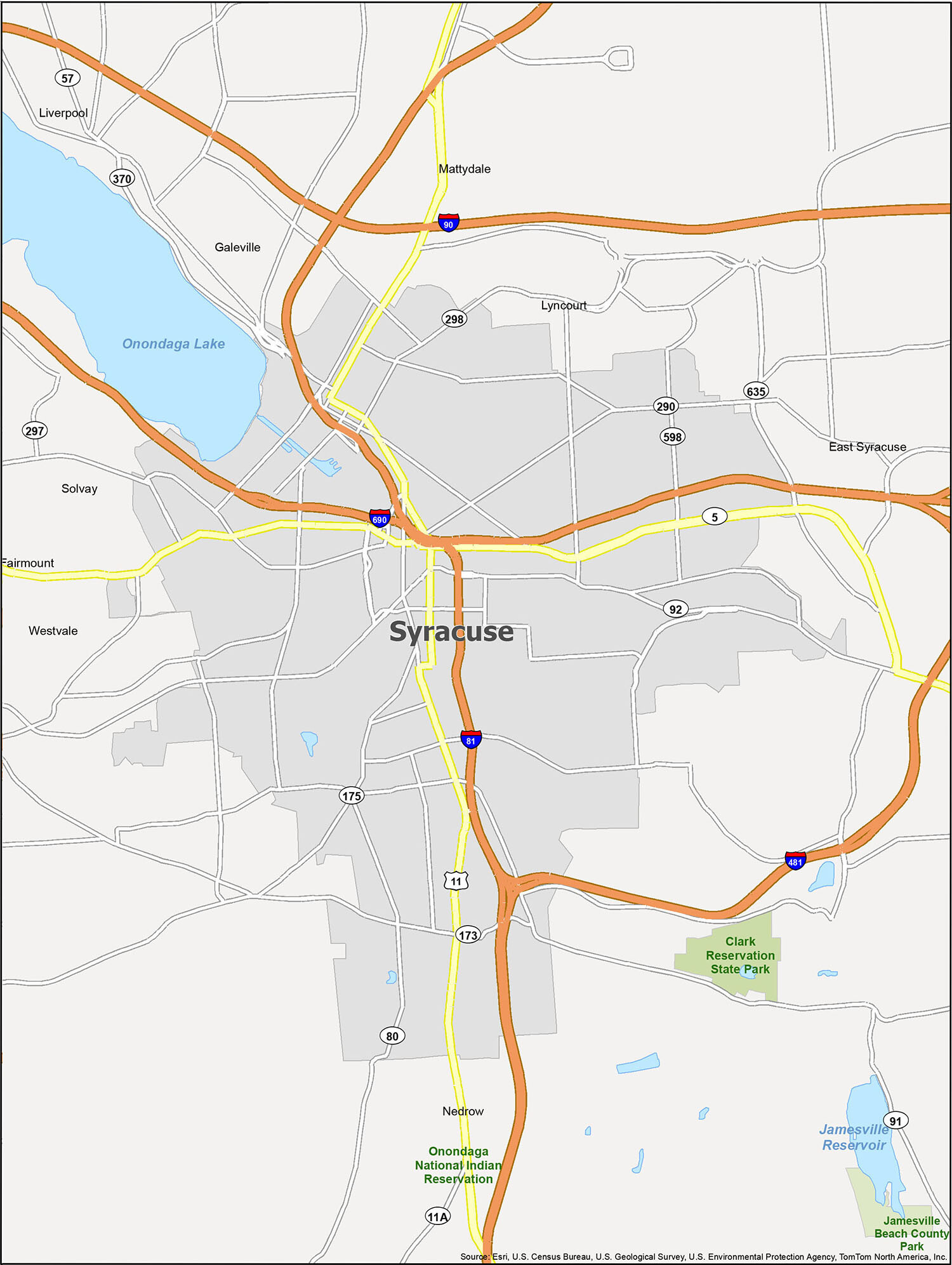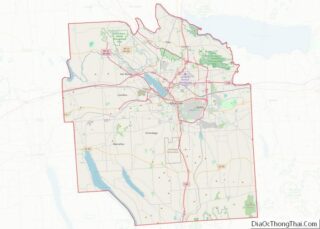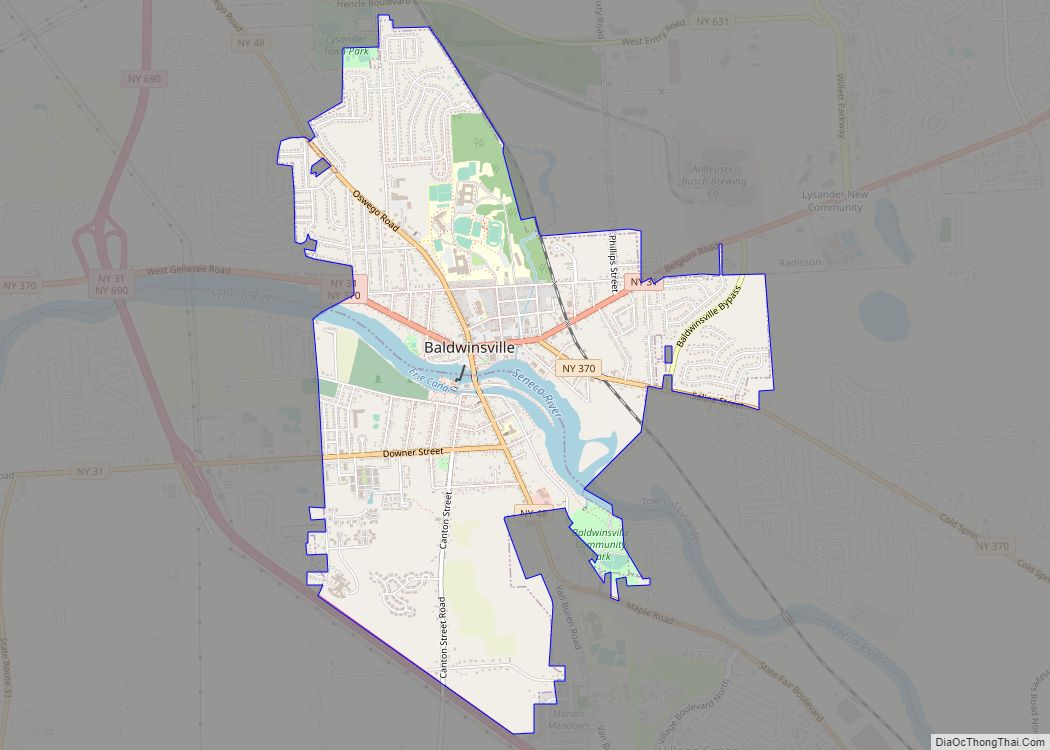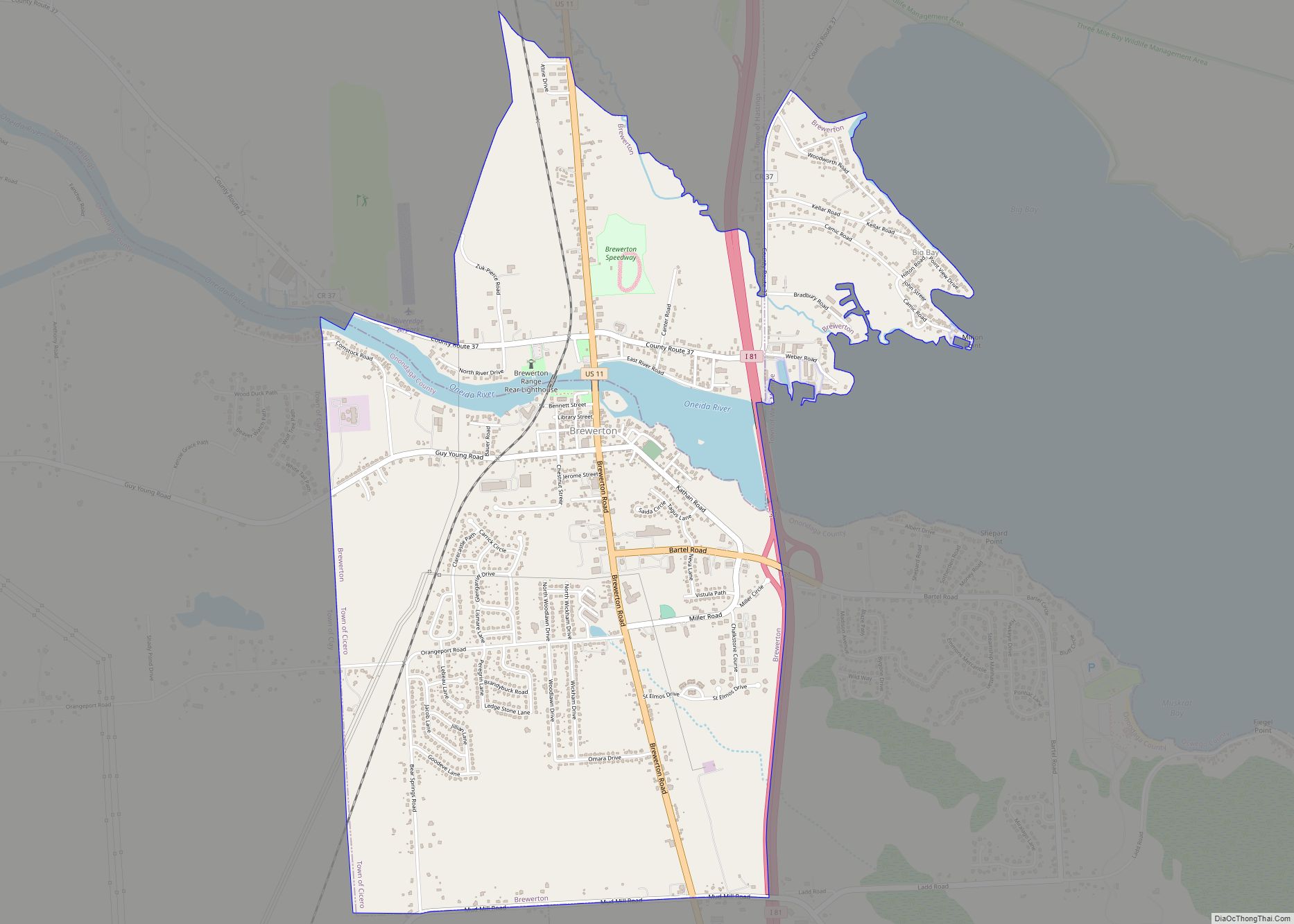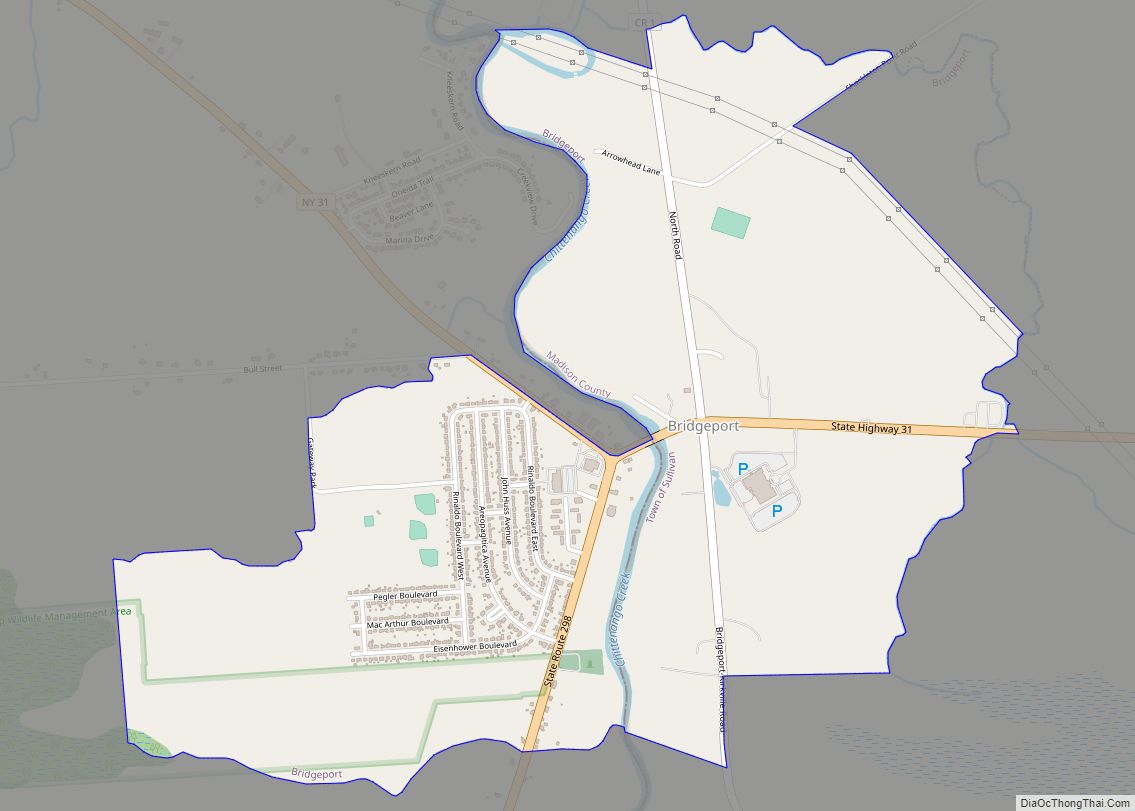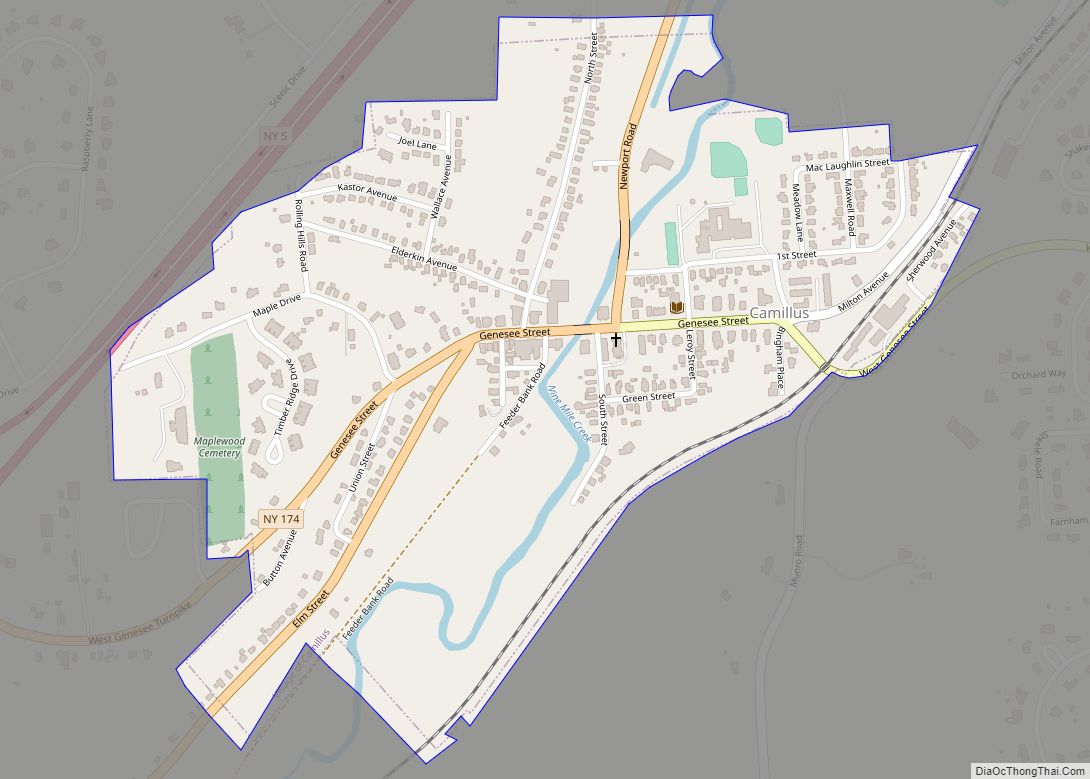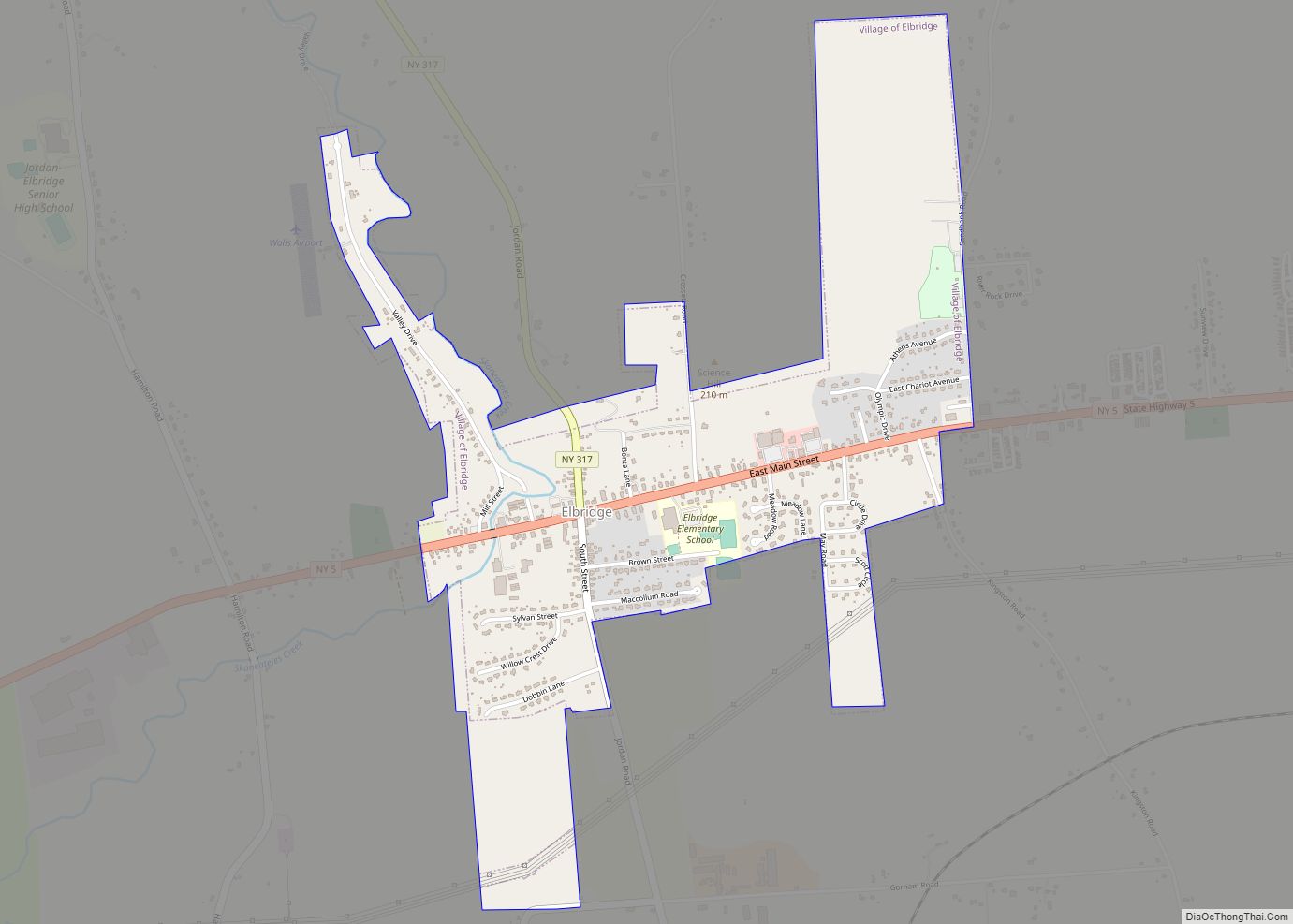Syracuse (/ˈsɪrəkjuːz, ˈsɛr-, -kjuːs/ SIRR-ə-kewz, SERR-, -kewss) is a city in and the county seat of Onondaga County, New York, United States. It is the fifth-most populous city in the state of New York following New York City, Buffalo, Yonkers, and Rochester.
At the 2020 census, the city’s population was 148,620 and its metropolitan area had a population of 662,057. It is the economic and educational hub of Central New York, a region with over one million inhabitants. Syracuse is also well-provided with convention sites, with a downtown convention complex. Syracuse was named after the classical Greek city Syracuse (Siracusa in Italian), a city on the eastern coast of the Italian island of Sicily.
Historically, the city has functioned as a major crossroad over the last two centuries, first between the Erie Canal and its branch canals, then of the railway network. Today, Syracuse is at the intersection of Interstates 81 and 90. Its airport is the largest in the Central New York region.
Syracuse is home to Syracuse University, SUNY Upstate Medical University, SUNY ESF, and Le Moyne College.
| Name: | Syracuse city |
|---|---|
| LSAD Code: | 25 |
| LSAD Description: | city (suffix) |
| State: | New York |
| County: | Onondaga County |
| Elevation: | 380–440 ft (116–135 m) |
| Land Area: | 25.06 sq mi (64.90 km²) |
| Water Area: | 0.58 sq mi (1.51 km²) 2.15% |
| Population Density: | 5,930.80/sq mi (2,289.88/km²) |
| ZIP code: | 132xx |
| FIPS code: | 3673000 |
| GNISfeature ID: | 0966966 |
| Website: | www.syr.gov |
Are you looking for a map of Syracuse? Look no further! Our map collection includes highways, roads, things to do, and an interactive map of the city. Whether you’re planning a trip to Syracuse or just want to explore the area, our maps are a perfect resource.
Syracuse is a city located in central New York and has a population of about 142,000 people. It is famous for Onondaga Lake, located to the northwest of Syracuse. The city also has some of the best parks in central New York, making it a great destination for visitors to explore.
Online Interactive Map
Click on ![]() to view map in "full screen" mode.
to view map in "full screen" mode.
Get a little closer to Syracuse and its history with this interactive map. Use the tools to browse hotels, restaurants, businesses, attractions, and other features in Syracuse. Plus, you can use the zoom tools to get a better understanding of all the different neighborhoods and attractions. Whether you’re looking to go for a weekend visit or plan a week-long adventure, this interactive map is perfect for your needs.
Syracuse location map. Where is Syracuse city?
History
French missionaries were the first Europeans to come to this area, arriving to work with and convert the Native Americans in the mid-17th century. At the invitation of the Onondaga Nation, one of the five nations of the Iroquois Confederacy, a Jesuit priest by the name of Simon Le Moyne, accompanied by soldiers and coureurs des bois, including Pierre Esprit Radisson, set up a mission, known as Ste. Marie de Gannentaha on the northeast shore of Onondaga Lake.
Jesuit missionaries reported salty brine springs around the southern end of what they referred to as “Salt Lake”, known today as Onondaga Lake in honor of the historic tribe. French fur traders established trade throughout the New York area among the Iroquois. Dutch and English colonists also were traders, and the English nominally claimed the area, from their upstate base at Albany, New York. During the American Revolutionary War, the highly decentralized Iroquois divided into groups and bands that supported the British, and two tribes that supported the American-born rebels, or patriots.
Settlers came into central and western New York from eastern parts of the state and New England after the American Revolutionary War and various treaties with and land sales by Native American tribes. The subsequent designation of this area by the state of New York as the Onondaga Salt Springs Reservation provided the basis for commercial salt production. Such production took place from the late 1700s through the early 1900s. Brine from wells that tapped into halite (common salt) beds in the Salina shale near Tully, New York, 15 miles south of the city, was developed in the 19th century. It is the north-flowing brine from Tully that is the source of salt for the “salty springs” found along the shoreline of Onondaga Lake. The rapid development of this industry in the 18th and 19th centuries led to the nicknaming of this area as “The Salt City”.
The original settlement of Syracuse was a conglomeration of several small towns and villages and was not recognized with a post office by the United States Government. Establishing the post office was delayed because the settlement did not have a name. Joshua Forman wanted to name the village Corinth. When John Wilkinson applied for a post office in that name in 1820, it was denied because the same name was already in use in Saratoga County, New York. Having read a poetic description of Syracuse, Sicily (Siracusa), Wilkinson saw similarities to the lake and salt springs of this area, which had both “salt and freshwater mingling together”. On February 4, 1820, Wilkinson proposed the name “Syracuse” to a group of fellow townsmen; it became the name of the village and the new post office.
The first Solvay Process Company plant in the United States was erected on the southwestern shore of Onondaga Lake in 1884. The village was called Solvay to commemorate the inventor Ernest Solvay. In 1861, he developed the ammonia-soda process for the manufacture of soda ash (anhydrous sodium carbonate) from brine wells dug in the southern end of Tully valley (as a source of sodium chloride) and limestone (as a source of calcium carbonate). The process was an improvement over the earlier Leblanc process. The Syracuse Solvay plant was the incubator for a large chemical industry complex owned by Allied Signal in Syracuse. While this industry stimulated development and provided many jobs in Syracuse, it left Onondaga Lake as the most polluted in the nation.
The salt industry declined after the Civil War, but a new manufacturing industry arose in its place. Throughout the late 1800s and early 1900s, numerous businesses and stores were established, including the Franklin Automobile Company, which produced the first air-cooled engine in the world; the Century Motor Vehicle Company; the Smith Corona company; and the Craftsman Workshops, the center of Gustav Stickley’s handmade furniture empire.
On March 24, 1870, Syracuse University was founded. The State of New York granted the new university its own charter, independent of Genesee College, which had unsuccessfully tried to move to Syracuse the year before. The university was founded as coeducational. President Peck stated at the opening ceremonies, “The conditions of admission shall be equal to all persons… there shall be no invidious discrimination here against woman…. brains and heart shall have a fair chance… ” Syracuse implemented this policy and attracted a high proportion of women students. In the College of Liberal Arts, the ratio between male and female students during the 19th century was approximately even. The College of Fine Arts was predominantly female, and a low ratio of women enrolled in the College of Medicine and the College of Law.
The first New York State Fair was held in Syracuse in 1841. Between 1842 and 1889, the Fair was held among 11 New York cities before finding a permanent home in Syracuse. It has been an annual event since then, except between 1942 and 1947, when the grounds were used as a military base during World War II, and in 2020, due to the outbreak of the COVID-19 pandemic.
As part of the racial incidents happening all over the country during the 1919 Red Summer, on July 31, 1919, there was a violent riot between white and black workers of the Syracuse Globe Malleable Iron Works.
Syracuse is home to the only “green on top” traffic light. The “green on top” traffic light was installed in 1928 as a result of local youths throwing rocks at the “British red” light that was originally on top. These locals became known as “stonethrowers” and the neighborhood now has the Tipperary Hill Heritage Memorial on the corner of Tompkins Street and Milton Avenue to commemorate this history.
World War II stimulated significant industrial expansion in the area: of specialty steel, fasteners, and custom machining. After the war, two of the Big Three automobile manufacturers (General Motors and Chrysler) had major operations in the area. Syracuse was also headquarters for Carrier Corporation, and Crouse-Hinds manufactured traffic signals in the city. General Electric, with its headquarters in Schenectady to the east, had its main television manufacturing plant at Electronics Parkway in Syracuse.
The manufacturing industry in Syracuse began to falter in the 1970s, as the industry restructured nationwide. Many small businesses failed during this time, which contributed to the already increasing unemployment rate. Rockwell International moved its factory outside New York state. General Electric moved its television manufacturing operations to Suffolk, Virginia, and later offshore to Asia. The Carrier Corporation moved its headquarters out of Syracuse, relocated its manufacturing operations out of state, and outsourced some of its production to Asian facilities. Although the city population has declined since 1950, the Syracuse metropolitan area population has remained fairly stable, growing by 2.5 percent since 1970. While this growth rate is greater than much of Upstate New York, it is far below the national average during that period.
Historic Clinton Square
Erie Canal in Syracuse
Salina Street
Fayette Street
Syracuse Road Map
Get a glimpse of the city with this Syracuse road map showing interstates, highways, and major roads of Syracuse. This map will help you plan your route and get a better sense of what you need to see while in town. Our road map will take you from the heart of the city to its suburbs and outlying villages. Print it off before you go and enjoy the convenience of it when traveling. But for any travel outside of Syracuse, take a look at our road map of New York state for more highway information.
Interstate Highways: I-81, I-481, I-690
US Highways: 5, 11, 39, 45, 80, 92, 173, 290, 298, 370, 598, 635, Seneca Tpke
Parkways: Onondaga Lake Pky
Major Roads: Adams St, Bear St, Brighton Ave, Butternut St, Clinton St, Colvin St, Court St, Erie Blvd, Franklin St, Genant Dr, Genesee St, Herald Pl, James St, Kennedy St, Raynor Ave, Rock Cut Rd, Salina St, South Ave, State St, Sunset Ave, Thompson Rd, Valley Dr, West St, Wolf St
Discover the vibrant city of Syracuse and the surrounding area with this interactive reference map. Get an overview of the neighborhoods, major attractions, nearby towns, and more. With this map, you can navigate around the city and plan your next trip with ease.
The Census-designated places in the area include Galeville, Lyncourt, Mattydale, Nedrow, and Westvale. The villages are East Syracuse, Liverpool, and Solvay. You can also explore the lakes and rivers such as Jamesville Reservoir and Onondaga Lake, as well as parks and recreation spots like Clark Reservation State Park, Jamesville Beach County Park, and Onondaga National Indian Reservation.
10 things to do in Syracuse city
Syracuse is a vibrant city with a wealth of tourist attractions and activities for you and your family to explore. Take a look at this map and get a sneak peek of what the city has to offer. From the Rosamond Gifford Zoo to Onondaga Lake Park, this map provides a unique experience and gives you some great ideas for things to do while you’re there. Here are 10 of the top things to do in Syracuse:
- Rosamond Gifford Zoo
- Onondaga Lake Park
- Everson Museum of Art
- Museum of Science & Technology
- Erie Canal Museum
- Destiny USA
- NBT Bank Stadium
- Webster Pond
- Clinton Square
- Niagara Mohawk Building
Syracuse city Satellite Map
Geography
Geography
Syracuse is located at 43°2′49″N 76°8′40″W / 43.04694°N 76.14444°W / 43.04694; -76.14444 (43.046899, −76.144423). It is located about 87 miles (140 km) east of Rochester, 150 miles (240 km) east of Buffalo, and 145 miles (230 km) west of the state capital, Albany. It is also the halfway point between New York City and Toronto, about 245 miles (390 km) from each, Toronto to the northwest and NYC to the southeast.
According to the United States Census Bureau, the city has a total area of 66 square kilometres (25.6 square miles), of which 65 square kilometres (25.1 square miles) is land and 1.6 square kilometres (0.6 square miles) (2.15%) water.
The city developed at the northeast corner of the Finger Lakes region. The city has many neighborhoods that were originally independent villages, which joined the city over the years. Although the central part of Syracuse is flat, many of its neighborhoods are on small hills such as University Hill and Tipperary Hill. Land to the north of Syracuse is generally flat, while land to the south is hilly.
About 27 percent of Syracuse’s land area is covered by 890,000 trees — a higher percentage than in Albany, Rochester or Buffalo. The Labor Day Storm of 1998 was a derecho that destroyed approximately 30,000 trees. The sugar maple accounts for 14.2 percent of Syracuse’s trees, followed by the Northern white cedar (9.8 percent) and the European buckthorn (6.8 percent). The most common street tree is the Norway maple (24.3 percent), followed by the honey locust (9.3 percent).
The densest tree cover in Syracuse is in the two Valley neighborhoods, where 46.6 percent of the land is covered by trees. The lowest tree cover percentage is found in the densely developed downtown, which has only 4.6 percent trees.
Syracuse’s main water source is Skaneateles Lake, one of the country’s cleanest lakes, located 24 kilometres (15 miles) southwest of the city. Water from nearby Onondaga Lake is not potable due to industrial dumping that spanned many decades, leaving the lake heavily polluted. Incoming water is left unfiltered, and chlorine is added to prevent bacterial growth. Most of the environmental work to achieve lake cleanup was scheduled to be completed by 2016; however Honeywell, the company tasked with the cleanup, announced the project’s completion in late 2017. For periods of drought, there is also a backup line which uses water from Lake Ontario.
Onondaga Creek, a waterway that runs through downtown, flows northward through the city. The Onondaga Creekwalk borders this, connecting the Lakefront, Inner Harbor, Franklin Square and Armory Square neighborhoods. The creek continues through the Valley and ultimately to the Onondaga Nation. The creek is navigable, but it can be a challenge. Its channelized nature speeds up its flow, particularly in the spring, when it may be dangerous. After some youngsters drowned in the creek, some residential areas fenced-off the creek in their neighborhoods.
Onondaga Creekwalk
Green Lakes State Park
Green Lakes State Park
Winter in Syracuse
Climate
Syracuse has a hot-summer humid continental climate (Dfa), as mean July temperatures are just above the 71.6 °F (22.0 °C) threshold needed for a hot-summer climate. The city is known for its high snowfall, 115.6 inches (2.94 meters) on average; Syracuse receives the most annual average snow of any metropolitan area in the United States. Syracuse usually wins the Golden Snowball Award among Upstate cities. Its record seasonal (July 1 to June 30 of the following year) snowfall so far is 192.1 in (4.88 m) during the winter of 1992–93, while the snowiest calendar month was January 2004, with 78.1 in (1.98 m) accumulated. The high snowfall is a result of the city receiving both heavy snow from the lake effect of nearby Lake Ontario (of the Great Lakes) and nor’easter snow from storms driven from the Atlantic Ocean. Snow most often falls in small (about 1–3 inches or 2.5–7.6 centimetres), almost daily doses, over a period of several days. Larger snowfalls do occur occasionally, and even more so in the northern suburbs.
The Blizzard of 1993 was described as the Storm of the Century. Some 42.9 in (109 cm) fell on the city within 48 hours, with 35.6 in (90 cm) falling within the first 24 hours. Syracuse received more snow than any other city in the country during this storm, which shattered a total of eight local records, including the most snow in a single snowstorm. A second notable snowfall was the Blizzard of 1966, with 42.3 in (107 cm). The Blizzard of ’58 occurred in February (16–17th) across Oswego and Onondaga counties. This storm was classified as a blizzard due to the high winds, blowing snow, and cold; 26.1 in (66 cm) of snow was measured at Syracuse and drifts reached 20 ft (6.1 m) in Oswego County. (See Thirtieth Publication of the Oswego County Historical Society, (1969) and The Climate and Snow Climatology of Oswego N.Y., (1971)
Syracuse on average receives an annual precipitation of 38.47 inches (977 millimeters), with the months of July through September being the wettest in terms of total precipitation, while precipitation occurs on more days each month during the snow season.
The normal monthly mean temperature ranges from 23.6 °F (−4.7 °C) in January to 71.3 °F (21.8 °C) in July. The record high of 102 °F (39 °C) was recorded on July 9, 1936, and the record low of −26 °F (−32 °C) has occurred three times since 1942, the last being February 18, 1979.
In the early 21st century, a handful of previous heat records have been broken in the city. For example, July 2020 became the hottest month on record, with a mean temperature of 77.1 °F (25.1 °C), while the summers (June–August) of 2005, 2020, and 2012 were, respectively, the hottest, third-hottest, and fourth-hottest summers on record. Additionally, 2017 and 2018 saw consecutive monthly high temperature records broken in February, of 71 °F (22 °C) on February 24, 2017, and 75 °F (24 °C) on February 21, 2018, in addition to four consecutive days at or above 60 °F (16 °C). The latter was the warmest winter day on record.
- ^ Mean monthly maxima and minima (i.e. the expected highest and lowest temperature readings at any point during the year or given month) calculated based on data at said location from 1991 to 2020.
- ^ Official records for Syracuse kept at downtown from August 1902 to April 1938, Syracuse Municipal Airport from May 1938 to September 17, 1949, and at Syracuse Hancock Int’l since September 18, 1949.
See also
Map of New York State and its subdivision:- Albany
- Allegany
- Bronx
- Broome
- Cattaraugus
- Cayuga
- Chautauqua
- Chemung
- Chenango
- Clinton
- Columbia
- Cortland
- Delaware
- Dutchess
- Erie
- Essex
- Franklin
- Fulton
- Genesee
- Greene
- Hamilton
- Herkimer
- Jefferson
- Kings
- Lake Ontario
- Lewis
- Livingston
- Madison
- Monroe
- Montgomery
- Nassau
- New York
- Niagara
- Oneida
- Onondaga
- Ontario
- Orange
- Orleans
- Oswego
- Otsego
- Putnam
- Queens
- Rensselaer
- Richmond
- Rockland
- Saint Lawrence
- Saratoga
- Schenectady
- Schoharie
- Schuyler
- Seneca
- Steuben
- Suffolk
- Sullivan
- Tioga
- Tompkins
- Ulster
- Warren
- Washington
- Wayne
- Westchester
- Wyoming
- Yates
- Alabama
- Alaska
- Arizona
- Arkansas
- California
- Colorado
- Connecticut
- Delaware
- District of Columbia
- Florida
- Georgia
- Hawaii
- Idaho
- Illinois
- Indiana
- Iowa
- Kansas
- Kentucky
- Louisiana
- Maine
- Maryland
- Massachusetts
- Michigan
- Minnesota
- Mississippi
- Missouri
- Montana
- Nebraska
- Nevada
- New Hampshire
- New Jersey
- New Mexico
- New York
- North Carolina
- North Dakota
- Ohio
- Oklahoma
- Oregon
- Pennsylvania
- Rhode Island
- South Carolina
- South Dakota
- Tennessee
- Texas
- Utah
- Vermont
- Virginia
- Washington
- West Virginia
- Wisconsin
- Wyoming


